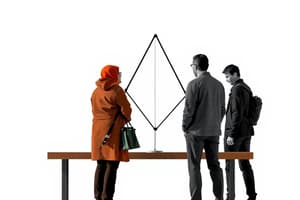Podcast
Questions and Answers
What is the Structural-Functional Paradigm?
What is the Structural-Functional Paradigm?
A macro-level perspective that views society as a complex system whose parts work together to promote stability.
Who is known as the founder of sociology?
Who is known as the founder of sociology?
Auguste Comte
What theory did Herbert Spencer propose?
What theory did Herbert Spencer propose?
Survival of the fittest
What was Emile Durkheim's focus in his studies?
What was Emile Durkheim's focus in his studies?
Who is considered a leading proponent of the Structural-Functional Paradigm in the US?
Who is considered a leading proponent of the Structural-Functional Paradigm in the US?
What are the three types of functions identified by Robert K. Merton?
What are the three types of functions identified by Robert K. Merton?
How has fashion historically maintained social order?
How has fashion historically maintained social order?
What does culture promote according to the Structural-Functional view?
What does culture promote according to the Structural-Functional view?
What are the main functions of mass media?
What are the main functions of mass media?
Flashcards are hidden until you start studying
Study Notes
Structural-Functional Paradigm
- Views society from a macro level as a complex system promoting solidarity and stability.
- Emphasizes social structures (stable patterns of behavior) and their functions (consequences for society).
- Focuses on social stability during times of significant change.
- Dominated sociological theory until the 1960s.
- Tends to overlook societal inequalities that can lead to conflict, including those based on class, race, ethnicity, and gender.
Auguste Comte
- Recognized as the founder of sociology.
- Advocated for positivism, emphasizing observation and scientific methods in social inquiry.
Herbert Spencer
- Proposed the "survival of the fittest" theory before Darwin.
- Suggested that success is destined for the most intelligent and productive, with societal patterns reflecting the traits of its most capable members.
Emile Durkheim
- Conducted studies on suicide, linking it to concepts of social solidarity.
- Examined how social structures and norms contribute to stability during societal changes.
- Argued that deviance, including crime, is a normal aspect of society.
Talcott Parsons
- Key figure in promoting structural-functionalism in the United States.
- Compared society to a living organism, identifying the specific tasks required for survival and stability.
Robert K. Merton
- Defined three types of functions within social structures:
- Manifest: intended and recognized consequences.
- Latent: unintended repercussions.
- Dysfunction: negative consequences for society.
Fashion
- Functions to maintain an orderly class system and social stratification.
- Historically followed a top-down approach, with trends set by high-fashion houses and replicated by the masses.
- In the 1960s, fashion became more democratic, with upper classes embracing lower-class styles, while stability persisted.
Culture
- Viewed as a system of integrated components promoting social solidarity and stability.
- Cultural universals, such as birth rites and marital customs, are common across diverse societies.
Mass Media
- Serves four primary functions:
- Unites diverse populations within society.
- Acts as a primary agent of socialization.
- Enforces social control to promote conformity.
- Provides entertainment, offering relief from everyday stress.
Studying That Suits You
Use AI to generate personalized quizzes and flashcards to suit your learning preferences.



